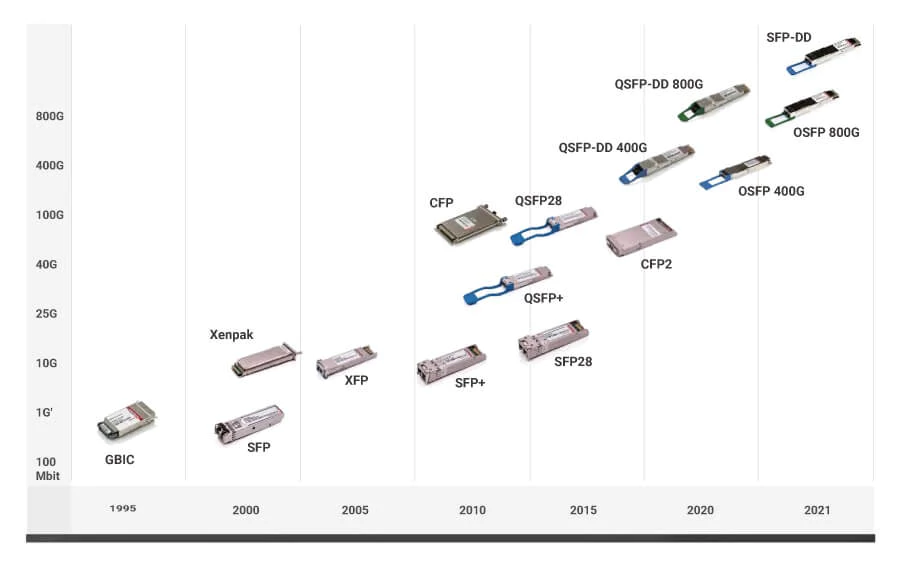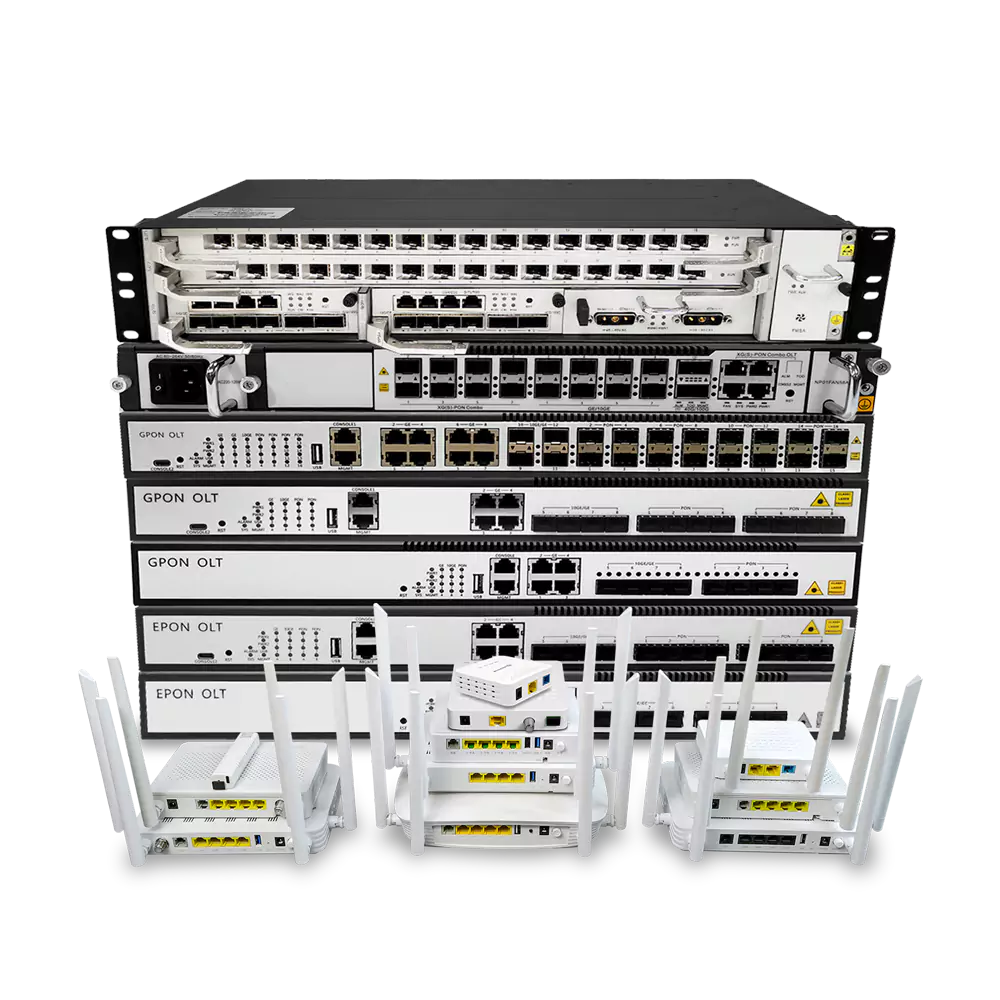The terms SFP, SFP+, XFP, QSFP, and QSFP+ all refer to different types of optical modules that are used in network devices like switches, routers, and servers to provide high-speed data transmission over optical fiber. These modules differ in terms of form factor, data rate, use cases, and application types. Below is a breakdown of the differences between each:
1. SFP (Small Form-factor Pluggable)
- Data Rate: Typically supports speeds up to 1 Gbps (though there are some newer modules that can support 2.5 Gbps).
- Form Factor: SFP is the smallest form factor in this family, making it suitable for applications where space is a constraint.
- Use Case: SFP modules are commonly used in Gigabit Ethernet (1G), Fiber Channel, and other low-speed applications. They are compatible with both single-mode and multi-mode fiber.
- Interface: Standard SFP modules have a LC (Lucent Connector) fiber optic interface.
- Transmission Distance: Varies by fiber type (multi-mode or single-mode) and the module’s design (short-range or long-range), typically up to 100 km for single-mode.
2. SFP+ (Enhanced Small Form-factor Pluggable)
- Data Rate: Supports 10 Gbps transmission speed.
- Form Factor: SFP+ is slightly enhanced over the original SFP in terms of speed and is backward compatible with SFP.
- Use Case: Used for 10 Gigabit Ethernet, Fiber Channel, and other high-speed networking applications. It’s commonly found in data centers, storage area networks (SANs), and high-performance computing.
- Interface: Uses the same LC fiber optic interface as the SFP but is designed to handle higher speeds.
- Transmission Distance: Similar to SFP, the distance depends on whether it’s a multi-mode or single-mode module, with ranges typically from a few hundred meters to several kilometers.
3. XFP (10 Gigabit Small Form-factor Pluggable)
- Data Rate: Supports 10 Gbps transmission speed.
- Form Factor: Larger than SFP+ and SFP, with a more robust design. XFP modules were developed before SFP+ to address the need for 10G speeds but have since been mostly replaced by SFP+.
- Use Case: XFP modules are used for 10 Gigabit Ethernet, SONET/SDH, and other 10G optical applications. They are still found in some older equipment but are becoming less common.
- Interface: XFP modules typically use the LC interface, similar to SFP+.
- Transmission Distance: Similar to SFP+ modules, ranging from short-range multi-mode fiber to long-range single-mode fiber, depending on the specific design.
4. QSFP (Quad Small Form-factor Pluggable)
- Data Rate: Supports 4 Gbps per lane, with 4 lanes, enabling a total of 16 Gbps transmission speed (often used in older 16G Fiber Channel applications). More commonly, QSFP can support up to 40 Gbps.
- Form Factor: Larger than SFP/SFP+ modules due to its quad-lane design, which allows for multiple channels of data transmission.
- Use Case: QSFP is used for high-speed interconnects in data centers, high-performance computing, and other network environments requiring high bandwidth. It’s designed for 40G Ethernet, InfiniBand, and other high-speed applications.
- Interface: Typically uses an LC or MPO interface, depending on the version.
- Transmission Distance: Similar to SFP and SFP+, depending on the fiber type and module design, ranging from a few meters (for multi-mode) to tens of kilometers (for single-mode).
5. QSFP+ (Quad Small Form-factor Pluggable Plus)
- Data Rate: Supports 40 Gbps transmission speed (4×10 Gbps per lane).
- Form Factor: Larger than SFP/SFP+ modules but slightly smaller than the full-size XFP. It provides 4 channels, enabling high throughput.
- Use Case: Commonly used for 40 Gigabit Ethernet (40G Ethernet), InfiniBand, and other high-bandwidth applications. It’s widely used in modern data centers and high-speed interconnection between servers and switches.
- Interface: Typically uses the MPO (Multi-Fiber Push On) interface for 40G transmission.
- Transmission Distance: Depending on whether it’s a short-range (SR) or long-range (LR) module, it can support distances from a few meters (multi-mode) up to 10-40 km (single-mode).

Summary of Key Differences
| Module Type | Data Rate | Form Factor | Use Case | Interface | Transmission Distance |
|---|---|---|---|---|---|
| SFP | 1 Gbps | Smallest of the group | Gigabit Ethernet, Fiber Channel | LC | Up to 100 km (single-mode), shorter for multi-mode |
| SFP+ | 10 Gbps | Slightly larger than SFP | 10 Gigabit Ethernet, SAN | LC | Varies (up to several km for single-mode) |
| XFP | 10 Gbps | Larger than SFP+ | 10G Ethernet, SONET/SDH | LC | Similar to SFP+ (up to several km for single-mode) |
| QSFP | 4 Gbps per lane, 16 Gbps total | Larger, quad-lane design | High-speed interconnects, 40G Ethernet | LC or MPO | Varies (up to 40 km for single-mode) |
| QSFP+ | 40 Gbps | Larger than SFP+ | 40G Ethernet, InfiniBand | MPO | Varies (up to 40 km for single-mode) |
Key Takeaways:
- SFP and SFP+ are smaller form factors, with SFP+ supporting higher speeds (10 Gbps).
- XFP is a larger module used primarily for 10G applications but is being phased out in favor of smaller SFP+ modules.
- QSFP and QSFP+ support multi-lane data transmission, making them suitable for 40G and higher-speed applications, with QSFP+ being the more common module used in modern networks.
- QSFP+ is typically used for 40 Gbps and higher bandwidth, while SFP+ is used for 10 Gbps connections.
The choice between these modules depends on the required speed, distance, and application in the network environment.

